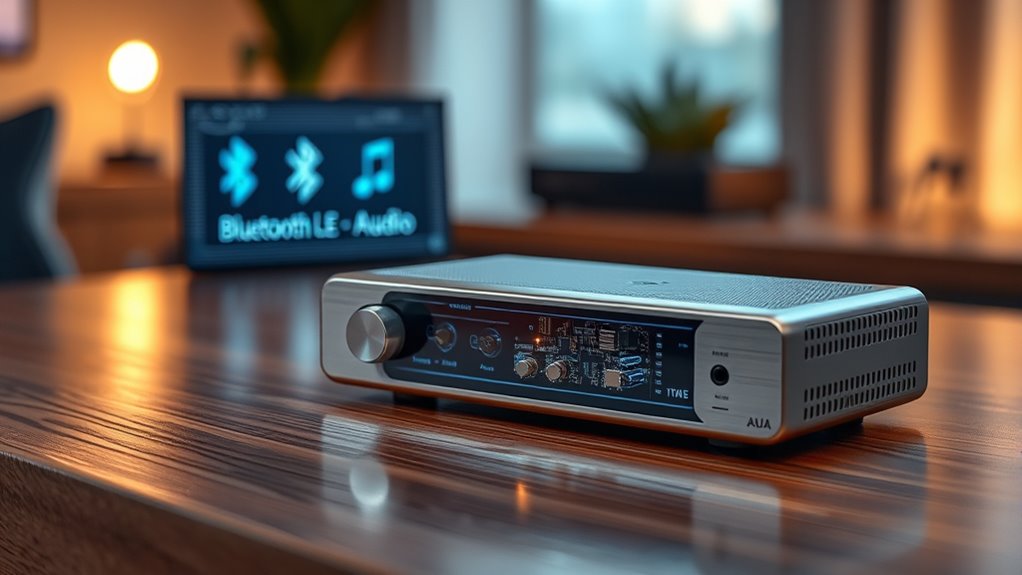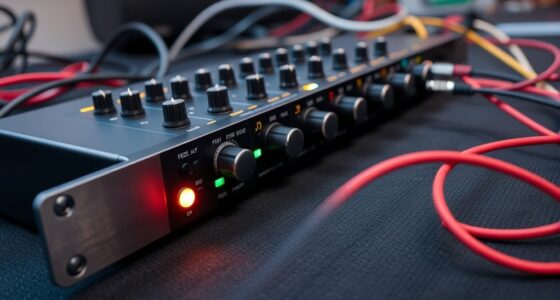Wireless streaming protocols have advanced from basic Bluetooth to Bluetooth LE Audio and Auracast, offering higher sound quality, lower power consumption, and seamless multi-device connections. LE Audio uses advanced compression and synchronized multi-streaming for better audio and efficiency. Auracast adds shared, personalized audio experiences across multiple devices securely. These innovations markedly improve user experience and industry standards—if you want to understand how these technologies work and shape the future, keep exploring more details.
Key Takeaways
- Bluetooth LE Audio introduces advanced compression, multi-stream support, and lower power consumption for high-quality, reliable wireless audio.
- Multi-stream connectivity and Auracast enable multiple devices to connect simultaneously, enhancing shared listening experiences.
- Wireless protocols now focus on reducing latency, improving interoperability, and supporting personalized sound profiles across devices.
- Industry standards are evolving to address licensing, compatibility, and security challenges for seamless wireless audio streaming.
- Future innovations aim to enhance immersive sound, ultra-reliable connectivity, and cross-platform interoperability through emerging technologies.
The Evolution of Wireless Audio Technologies
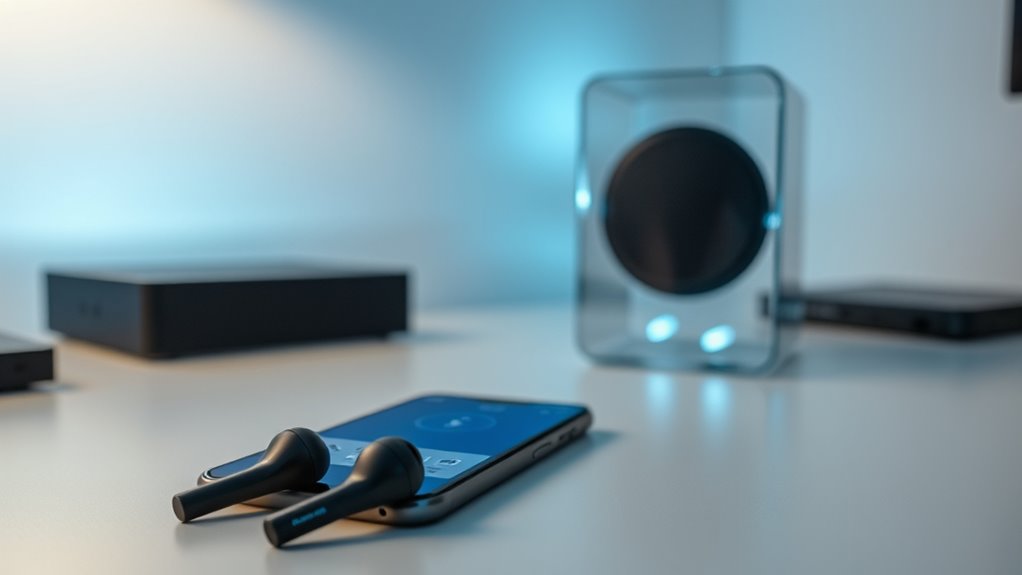
Wireless audio technologies have rapidly evolved over the past few decades, transforming how you listen to music and communicate. Early systems struggled with limited wireless bandwidth, causing choppy sound and frequent dropouts. As technology advanced, higher bandwidth allowed for clearer audio quality and more reliable connections. Engineers also worked to reduce audio latency, ensuring sound syncs perfectly with on-screen actions or live performances. This progress means you experience less delay and more immersive sound, whether streaming music, gaming, or making calls. Today’s wireless standards prioritize both high-quality audio and seamless performance, making wireless listening more convenient and enjoyable. Continuous improvements in wireless bandwidth and latency pave the way for even more sophisticated audio experiences in the future, keeping you connected effortlessly. Additionally, advancements in audio codecs enable more efficient compression and transmission of high-fidelity sound.
Understanding Bluetooth Low Energy (LE) Audio
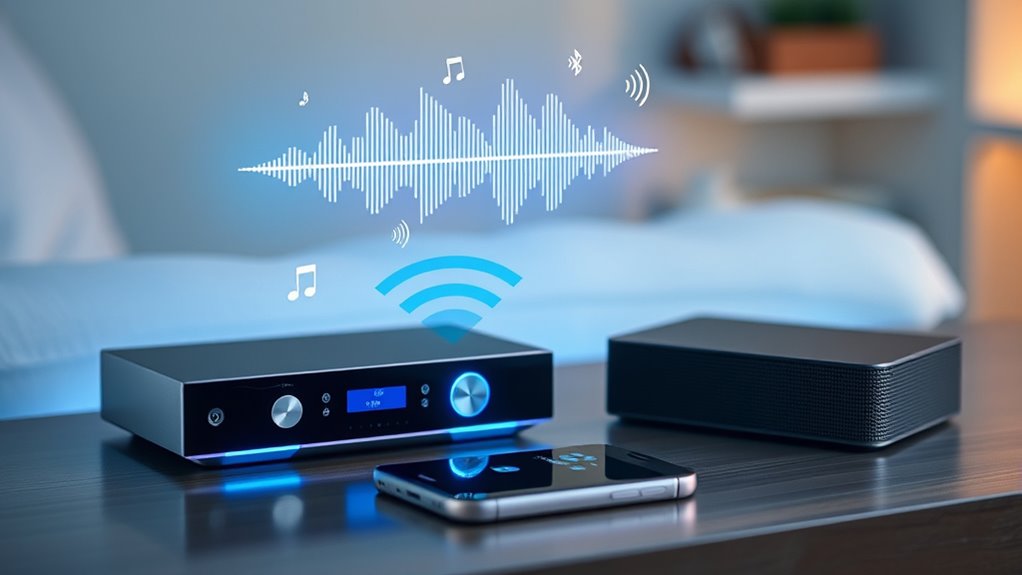
Bluetooth Low Energy (LE) Audio represents a significant advancement in wireless sound technology, offering improved efficiency and performance over traditional Bluetooth audio. It employs advanced audio compression techniques to transmit high-quality sound with lower power consumption, making devices more energy-efficient. Signal processing plays a vital role in LE Audio, enabling features like synchronized streaming to multiple devices and maintaining audio quality even at reduced bitrates. You’ll notice that LE Audio’s architecture minimizes latency and enhances stability, ensuring a seamless listening experience. By utilizing the LE Audio protocol, you can expect better battery life and more reliable connections, especially in scenarios requiring multiple simultaneous streams. Additionally, the integration of vetted 1st Home Theatre Projector technology ensures that the audio remains clear and immersive even in complex setups. Overall, understanding how audio compression and signal processing work together helps you grasp LE Audio’s superior performance in modern wireless audio applications.
Key Features and Benefits of LE Audio
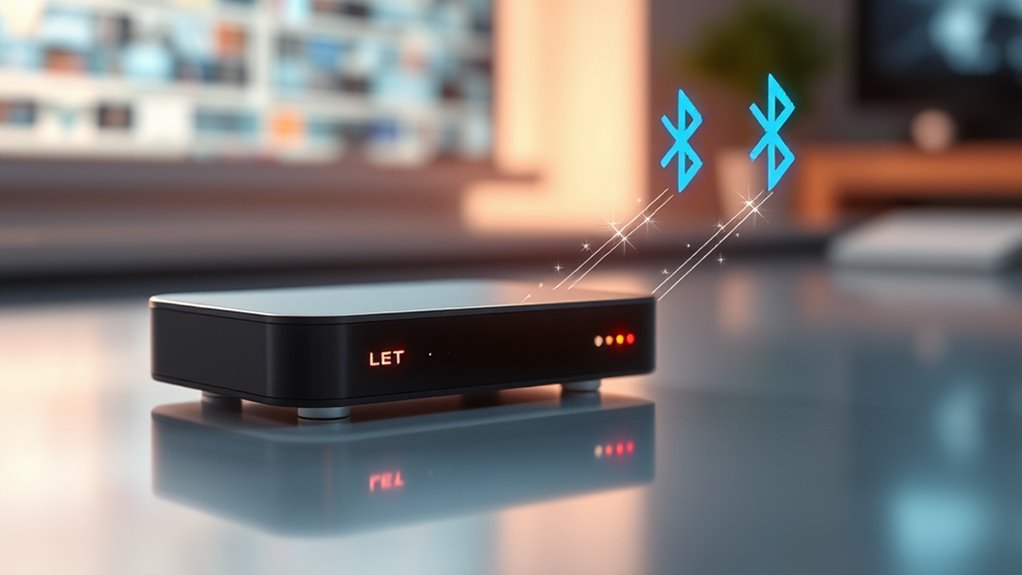
LE Audio offers improved sound quality, making your listening experience clearer and richer. It also uses less power, so your devices last longer without frequent charging. Plus, multi-stream connectivity lets you connect multiple devices simultaneously, enhancing convenience and versatility. Additionally, LE Audio’s enhanced audio technology is designed to support advanced features like spatial sound, further enriching the listening experience.
Enhanced Audio Quality
Thanks to advancements in audio compression and transmission, LE Audio delivers substantially improved sound quality that enhances your listening experience. It uses lossless compression to preserve audio fidelity, ensuring you hear sounds as intended. This results in clearer, richer sound, even at lower bitrates. Here are key benefits:
- Superior clarity with reduced distortion
- Richer, more natural soundscapes
- Better preservation of original audio details
- Increased listening immersion
Bioluminescent fungi exploration has also inspired innovative sound healing techniques that utilize natural frequencies for holistic health benefits.
Low Power Consumption
Building on the improved audio quality, LE Audio is designed to maximize efficiency by markedly reducing power consumption. This protocol enhances battery efficiency, allowing devices to run longer without frequent recharging. Its advanced power management features optimize resource use, ensuring minimal energy is wasted during streaming. LE Audio employs low-energy Bluetooth technology, which intelligently adjusts transmission power based on the distance and environment, further conserving battery life. This focus on low power consumption benefits users by providing extended usage time and reducing the need for frequent charging. Whether you’re using wireless earbuds or hearing aids, LE Audio’s efficient power management ensures that your devices stay powered longer, delivering reliable performance without compromising on audio quality or convenience. Additionally, device interoperability is improved, enabling seamless connection with a broader range of compatible products.
Multi-Stream Connectivity
Multi-Stream Connectivity is a key feature that allows multiple audio streams to be transmitted simultaneously between your devices, enhancing the listening experience. This capability enables you to connect and switch between devices effortlessly, providing a seamless audio experience. With multi stream connectivity, you can enjoy synchronized audio on multiple devices, like earbuds or speakers, without lag or distortion. It also improves device compatibility, ensuring a broader range of devices work together smoothly. Additionally, it supports celebrity lifestyle insights, highlighting its influence on how consumers integrate technology into their daily routines. Here are four benefits you’ll notice: 1. Simultaneous multi-device audio streaming 2. Better synchronization for true wireless experience 3. Easier device switching without interruptions 4. Enhanced compatibility across different brands and models
The Role of Auracast in Wireless Sound Transmission
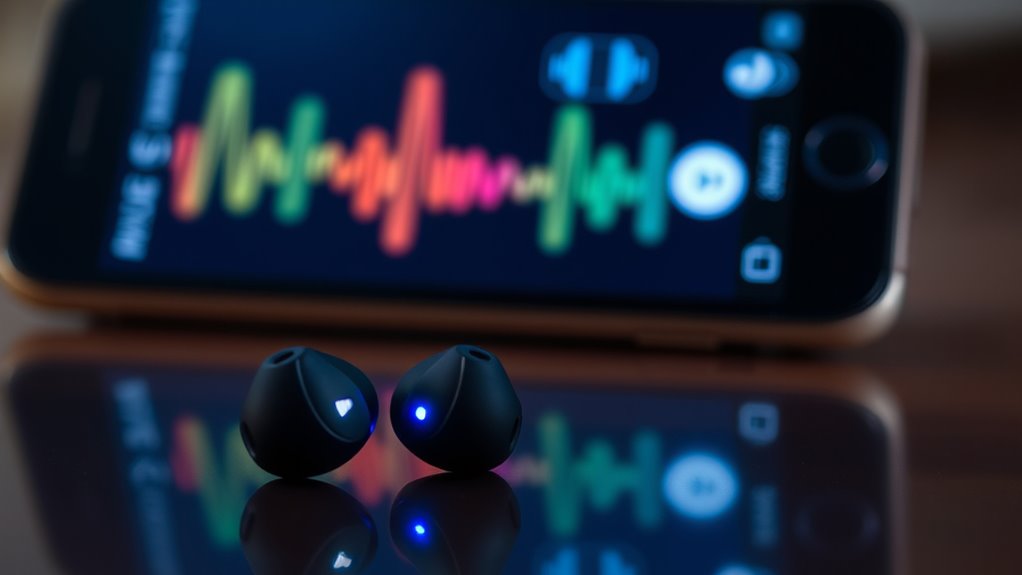
Auracast plays a pivotal role in wireless sound transmission by enabling seamless, shared audio experiences across multiple devices. It allows you to personalize sound settings for different listeners while maintaining high-quality audio streaming. This technology enhances sound personalization, making it easier to customize audio for individual preferences without interrupting others. Additionally, inspirational quotes about fatherhood can serve as a source of motivation and connection in shared listening environments, fostering a sense of community and support. However, privacy concerns also come into play, as shared audio streams can potentially expose sensitive information if not properly secured. Auracast addresses this by implementing encryption and access controls, ensuring that only authorized users can connect and listen. This balance between shared experiences and privacy safeguards makes Auracast a valuable addition to wireless sound transmission, fostering social audio interactions without compromising security.
Comparing Bluetooth LE Audio and Auracast
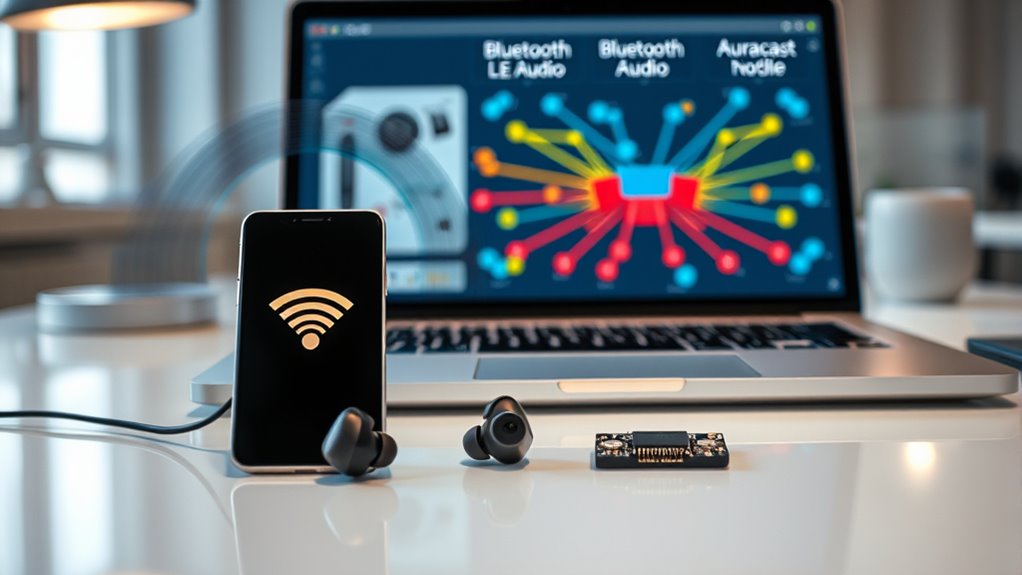
Bluetooth LE Audio and Auracast both aim to enhance wireless sound experiences, but they serve different functions and offer unique advantages. Bluetooth LE Audio focuses on improved audio compression, enabling higher quality sound with lower power consumption and broad device compatibility. Auracast, on the other hand, emphasizes multi-device streaming and shared listening, leveraging existing Bluetooth infrastructure.
Bluetooth LE Audio improves sound quality and efficiency, while Auracast enables shared listening across multiple devices.
Consider these key differences:
- Audio compression techniques impact sound clarity and latency.
- Device compatibility varies; Bluetooth LE Audio requires newer hardware.
- Bluetooth LE Audio supports point-to-point connections efficiently.
- Auracast enables multiple devices to connect simultaneously, ideal for shared environments.
Understanding these distinctions helps you choose the right protocol based on your audio quality and device ecosystem needs.
Impact on Consumers and Industry Standards
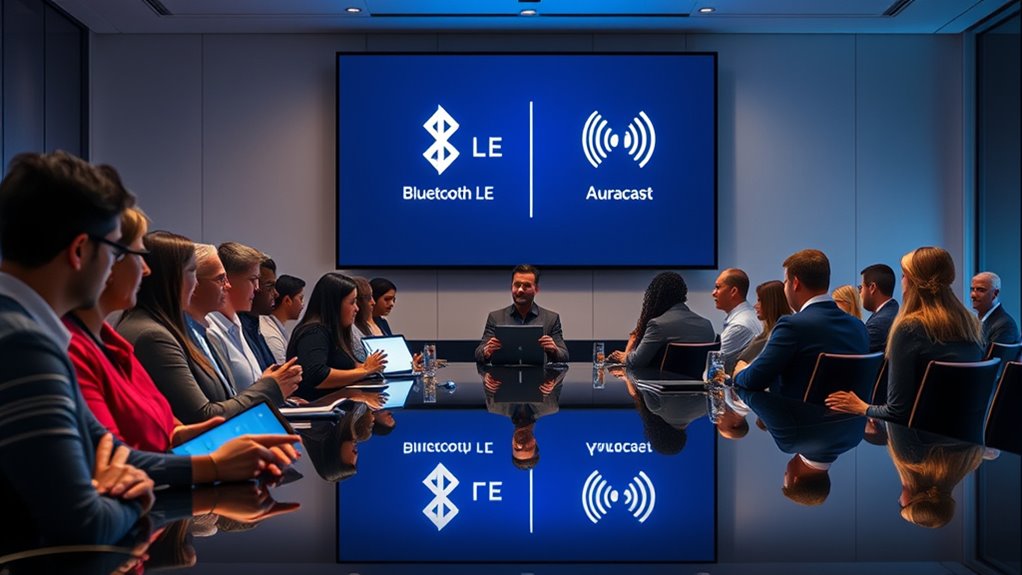
As wireless streaming protocols improve, you’ll notice a smoother and more reliable user experience across devices. Industry standards are advancing to guarantee better interoperability, making it easier for different products to work together seamlessly. These changes benefit consumers and push the industry toward greater consistency and innovation. Additionally, innovations in Kia Tuning demonstrate how industry-specific enhancements can optimize performance and personalization across various markets.
Enhanced User Experience
Enhanced user experience is a key driver behind the adoption of advanced wireless streaming protocols, shaping both consumer satisfaction and industry standards. These protocols offer features that make your listening more personalized and secure.
Here are four ways they improve your experience:
- Customization with personalization features, allowing tailored sound profiles and device settings.
- Faster, more reliable connections that reduce interruptions.
- Security enhancements that protect your data and prevent unauthorized access.
- Seamless multi-device switching for effortless progression between your gadgets.
These innovations ensure you enjoy high-quality audio with minimal hassle. As industry standards evolve, you benefit from consistent, secure, and personalized streaming, making your audio experience more enjoyable and intuitive every day. Cookies play a crucial role in enhancing your browsing experience and enabling personalized content, further supporting the seamless functionality of wireless protocols.
Industry Interoperability Advances
Advances in industry interoperability are transforming how devices communicate, making it easier for you to connect and enjoy your audio content across multiple platforms. Improved cross-platform compatibility means you can seamlessly switch devices without hassle, enhancing your overall experience. However, licensing challenges remain a hurdle for manufacturers, complicating the development of universally compatible solutions. These challenges can slow down the adoption of new standards and limit device interoperability. Industry stakeholders are actively working to streamline licensing processes and establish common standards, which benefits you by ensuring more reliable and versatile audio streaming options. Additionally, ongoing efforts to develop interoperability standards are crucial for fostering a more cohesive ecosystem. Ultimately, these interoperability advances promote a more unified ecosystem, giving you greater freedom to choose devices and enjoy high-quality audio without compatibility concerns.
Challenges and Limitations of Current Protocols
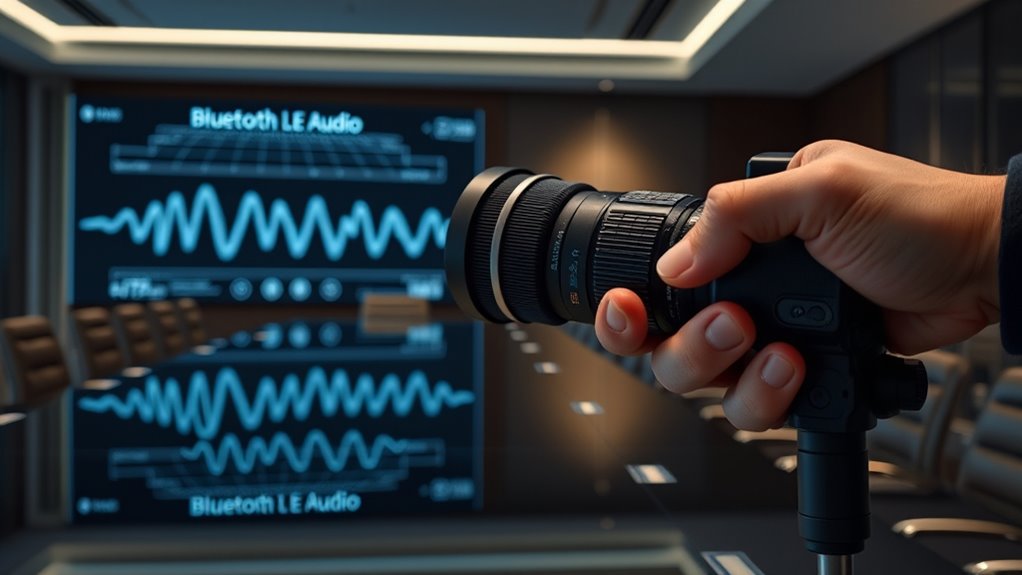
Despite their widespread use, current wireless streaming protocols face significant challenges that limit their effectiveness. These include interoperability issues, where devices struggle to communicate seamlessly, and bandwidth constraints, which restrict audio quality and stability. To understand these limitations better, consider:
- Limited device compatibility across different protocols
- Insufficient bandwidth for high-resolution audio streaming
- Latency issues affecting real-time audio synchronization
- Power consumption concerns impacting device longevity
These issues hinder smooth user experiences and restrict the full potential of wireless audio. Interoperability remains a major hurdle, especially as new standards emerge. Bandwidth constraints prevent delivering the best audio quality, especially for multi-channel or high-fidelity content. Overcoming these challenges is essential for future advancements in wireless streaming.
Future Directions in Wireless Audio Streaming
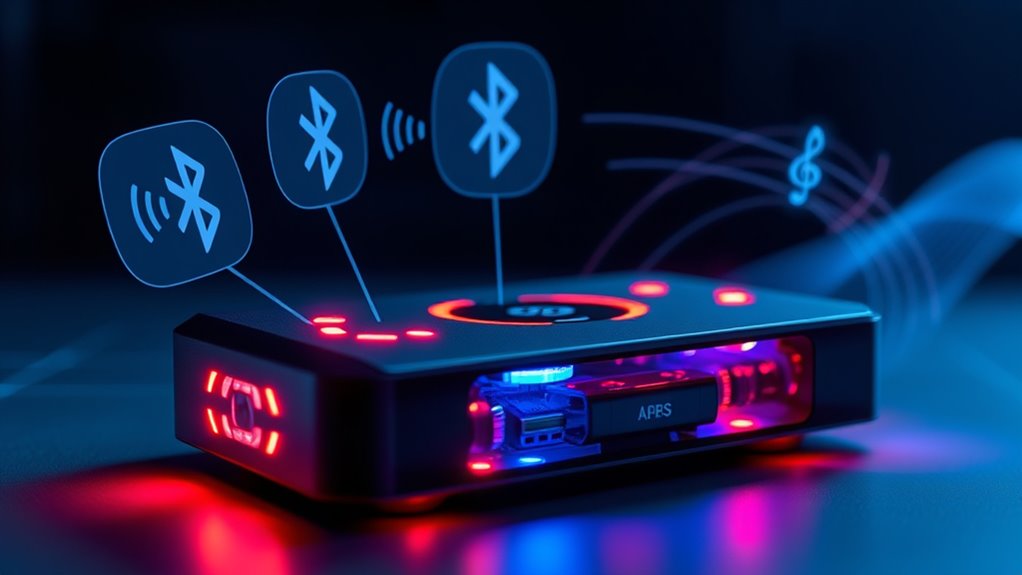
Looking ahead, the future of wireless audio streaming hinges on overcoming current protocol limitations through innovative technologies and standards. Augmented Sound will enhance your listening experience by layering virtual elements onto real-world audio, creating immersive environments. Quantum Connectivity promises near-instant, ultra-reliable connections, reducing latency and dropouts. These advancements will enable seamless, high-fidelity experiences across multiple devices simultaneously.
| Technology | Impact on Wireless Audio | Key Benefit |
|---|---|---|
| Augmented Sound | Adds virtual layers to real audio | Immersive, personalized sound |
| Quantum Connectivity | Instant, reliable links | Reduced latency, stability |
| AI-Driven Optimization | Smarter, adaptive streaming | Enhanced efficiency |
How to Choose the Right Wireless Audio Solution
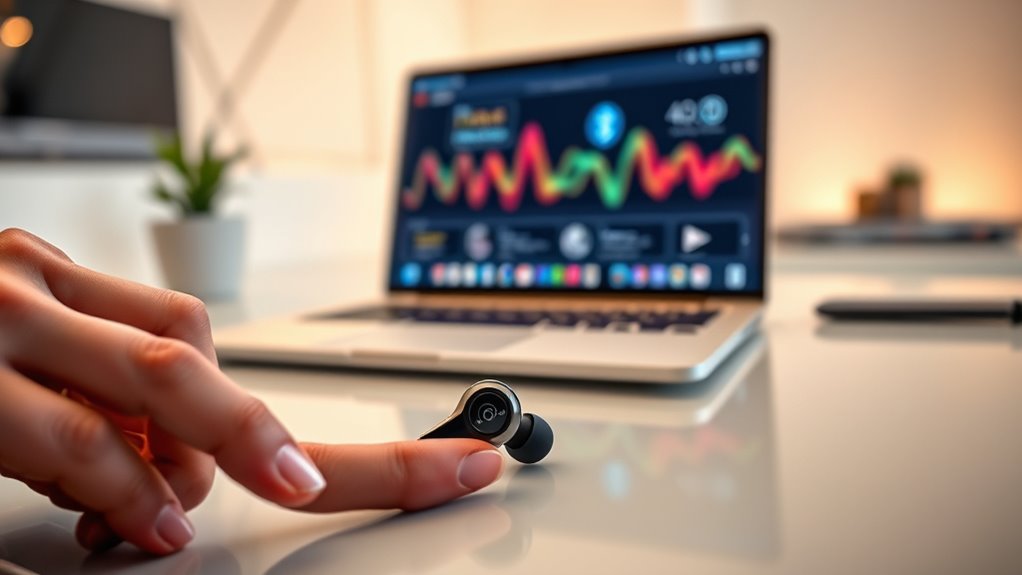
Choosing the right wireless audio solution depends on understanding your specific needs and how different protocols align with them. To make an informed choice, consider these key factors:
Selecting the ideal wireless audio setup requires matching protocols to your unique preferences and requirements.
- Wireless Compatibility – Ensure the protocol works seamlessly with your devices, whether it’s Bluetooth LE Audio or Auracast.
- Device Affordability – Balance the cost of compatible devices with your budget to avoid overspending.
- Audio Quality – Decide if you need high-fidelity sound or if basic streaming suffices.
- Connectivity Range – Think about how far you need the audio to reach without interruptions.
Frequently Asked Questions
How Does Latency Vary Across Different Wireless Streaming Protocols?
Latency varies across wireless streaming protocols because each one handles latency optimization differently. Some protocols, like Bluetooth LE Audio, focus on low latency by optimizing protocol synchronization, reducing delays during transmission. Others might have higher latency due to less efficient synchronization mechanisms. Your experience depends on how well the protocol manages latency optimization, ensuring minimal delay for seamless audio streaming. Choosing the right protocol depends on your need for low latency and reliable synchronization.
Are There Compatibility Issues Between Older Devices and Newer Protocols?
You might feel like your old device is fighting an uphill battle against shiny, new protocols. Compatibility issues can arise, especially if your device lacks protocol backward compatibility. While newer protocols aim to be more versatile, some older devices may struggle to connect or perform efficiently. To avoid frustration, check your device’s compatibility with the latest protocols, and consider updates or adapters that support backward compatibility for seamless streaming.
What Security Measures Protect Wireless Audio Transmissions?
You should know that security measures like encryption standards protect wireless audio transmissions from eavesdropping and tampering. Authentication mechanisms verify the devices involved, ensuring they’re authorized to communicate. These protocols work together to keep your audio streams private and secure. As wireless technology advances, these security features become even more critical, guarding your data and maintaining a safe, reliable connection between your devices.
Can Multiple Devices Stream Simultaneously Without Interference?
Imagine a symphony of devices, each streaming perfectly without a single note of interference! With advanced interference management, multi-device streaming becomes seamless, like a well-choreographed dance. Technologies like Bluetooth LE Audio and Auracast coordinate signals so multiple devices can stream simultaneously without clashes. You won’t experience dropouts or static—just pure, synchronized audio across all your gadgets, making multi-device streaming effortless and crystal clear.
How Do Wireless Protocols Impact Battery Life of Portable Audio Devices?
Wireless protocols substantially impact your portable audio device’s battery life by influencing power consumption and device efficiency. When a protocol is optimized, it uses less energy, allowing your device to last longer. For example, Bluetooth LE Audio reduces power consumption compared to older Bluetooth versions, enhancing efficiency. So, choosing devices with advanced wireless protocols helps conserve battery life, giving you more playtime without frequent recharges.
Conclusion
As you navigate the evolving landscape of wireless audio, remember that staying informed is your best armor against obsolescence—much like a wise knight of yore. Bluetooth LE Audio and Auracast are shaping the future, offering richer sound and seamless sharing. Embrace these innovations now, and you’ll be prepared to enjoy crystal-clear audio wherever you go, turning your listening experience from a mere trifle into a veritable symphony of modern technology.

